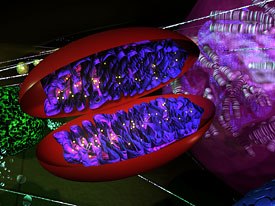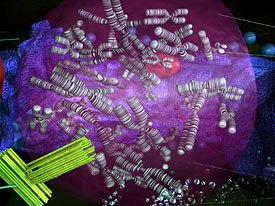Marisa Materna looks at training in a totally different world of animation -- non-entertainment science-based 3D.

Professor Albert William of IUPUI shows the gap between two neurons that a nervous impulse crosses by using neurotransmitters. All of Prof. William's images © 2004 Albert Wlliam, School of Informatics, IUP
Weve all been faced with that questionSo, whats your major?
In the educational world today, particularly animation, the answer to this question may not be exactly what you would expect. Animation has infiltrated such a wide variety of industries that you just might hear the words informatics, holography or even forensic science in response to this query.
Any recruiter or career counselor would wisely advise you to keep your options and mind open to all opportunities when selecting a college or career path. As a studio recruiter myself, I constantly advised aspiring animators and artists to be realistic about their abilities and talents in this challenging industry. I would ask them to keep their eye on the big picture simply to get paid to do what they love, draw or animate, in whatever capacity that might be. This may open up a whole new world of career choices that still allow you to be creative and innovative.
Fortunately, many colleges are also opening their horizons and curriculums, by offering degrees and certificates in a myriad of skills that can be exciting and creatively inspiring. Currently, there are hundreds of art schools that offer courses and degrees in non-entertainment technical areas.
3D technology is everywhere it seems, and no more so than in the forensic and criminal science world. Trials of the Century aside, graphics, visual effects and animation are becoming increasingly important in the criminal justice system. With re-enactments, tracking, fingerprinting and room outlines, 3D capabilities can make this tedious work more efficient and accurate. It is becoming standard practice in law enforcement.
Take, for example, The Henry Lee Institute for Forensic Science in West Haven, Connecticut, that is utilizing a new software called DeltaSphere-3000 3D Scene Digitizer that captures both the 3D measurements and full-color image of a crime scene quickly and easily. It is designed specifically for crime scene investigators and creates 3D models of a crime scene including blood spatter analysis in the model. As this school and others like it increasingly rely on this type of tool, they will need students with an affinity for 3D technology as well as in interest in forensic science.
Consider the possibilities.

The toy and footwear industries are booming areas for artists. The Fashion Institute for Design and Merchandising (Los Angeles campus shown above) offers a degree in footwear design.
How about a career in holography? The Rochester Institute of Technologys College of Imaging and Design in New York has a course study for this unusual medium. Holography may evoke memories of Princess Leia in Star Wars, but this media is used in a variety of ways including museums, medical investigation and nuclear engineering such as the safe design of containers used to transport or store nuclear materials.
It is amazing to think of all of the ways holography affects our lives. A telephone credit card used in Europe has embossed surface holograms, which carry a monetary value. Supermarket scanners read the bar codes on merchandise for the stores computer by using a holographic lens system. Holography is used to depict the shockwave made by air foils to locate the areas of highest stress. These holograms are used to improve the design of aircraft wings and turbine blades. A holographic lens is used in an aircraft heads-up display to allow a fighter pilot to see critical cockpit instruments while looking straight ahead through the windscreen. Holography is ideal for archival recording of valuables or fragile museum artifacts.

IUPUIs School of Informatics encompasses healthcare informatics and administration degrees, and the animation, media arts and digital graphics majors. Created by Prof. William with Maya 4, the above image is a representation of a mitochondria.
Consider the possibilities.
NYUs Center for Design, Digital Arts and Film offers a certificate in medical animation and digital effects. This degree offers courses for those interested in breaking into the new field known as medical imaging. In one of the introductory courses, you use Maya to explore and solve problems specific to medical visualization. Youll learn techniques for creating complex organic surfaces for human anatomy; digitally create eyes, bones, skin and muscle, and animate dynamic surgical situations. Consultants from the medical school help teach these courses. Other courses emphasize lighting, color and texturing techniques as well as tools that complement 3D such as Flash and Final Cut Pro for packing and delivery.
This degree could be an excellent alternative for someone who is interested in learning 3D technology, but may have a fascination for medical science. The healthcare industry is one that will never go away and a career in this area may have longevity and security.
Similarly, IUPUI (Indiana University-Purdue University Indianapolis) has an entire college called the School of Informatics that encompasses not only Healthcare Informatics and Administration degrees, but also the Animation, Media Arts and Digital Graphics majors. This offers a great deal of cross-pollination of core coursework for the Health Informatics students and Animation and Media Arts students. These include Information Infrastructure, which focuses on computer programming, Multimedia Arts and Technology highlighting social issues contemplating the paradigm shift to a digital world and how it will affect humanity; and media courses such as Web Programming and CGI Special Effects.
There are two unique and growing departments at the University of Central Florida in Orlando. They offer a masters and PhD specifically in the field of modeling and simulation. This program resides in the school of film and digital media. Graduates of this program work in one of seven focus areas and this gives them the diverse training necessary for them to work in government agencies, or in the defense, entertainment and manufacturing industries. The core of the coursework emphasizes knowledge on modeling approaches, human factors, computing infrastructure and visual representation.

Rochester Institute of Technologys School of Photographic Arts and Sciences offers a holography course. Above is the Eastman Kodak quad (left) and the Yasuji Tojo Memorial Japanese Garden at lower right.
Also in this school is the UCF digital media program, which allows students to integrate the multiple disciplines of art, literature and technology. The major includes emphasis on areas such as: visual language, digital music, tools for digital music, Internet and interactive systems, writing for media as well as the more traditional degrees in film and interactive media.
This university is unique in that it has a sub-section of the film and digital media department that is devoted entirely to the marriage of art and technology. CREAT, the Consortium for Research Education in the Arts and Technology, is a partnership of the art, English, film and music departments in the college of arts and sciences, with support from the school of electrical engineering and computer science and the Institute of Simulation and Training. CREAT offers a B.S. and a B.A in digital media as well as a certificate. Depending on the students focus, the coursework is a combination of mathematics, arts, music, 3D software and film techniques. The program is growing and there are more than 200 majors in the department.
The department also focuses on recruitment and establishment of outside industrial partners in order to further prepare its students. Each month the Website (www.dm.ucf.edu) features a student artist and posts their work on the site. This is a terrific way to promote the students work, provide a marketing tool for job placement and establishes a creative community among the students.

The blend of 3D technology and medical science is a growing field. Above is IUPUIs Professor William visualizes the cell's nucleus and shows the 23 pairs of chromosomes prepared for mitosis. This was created in Maya 4.
There are a tremendous amount of options for those who have strong drawing skills, but arent set on being an animator. Two in particular, toy and footwear, are booming industries that one might never consider, but the toy business alone is a multi-billion dollar industry. The opportunities are boundless for an artist that loves character design or cartooning. Schools such as the Otis College of Art and Design in Los Angeles, offer degrees specifically in toy design. The curriculum focuses on specific toy categories. Sophomores work with plush, infant and preschool toys; juniors concentrate on vehicles and male action toys, while seniors design large and small dolls, games and puzzles, as well as an open category. Mattel and other toy companies are closely allied with the department, and industry professionals serve as instructors and mentors.
Another industry that has jumped into the forefront is the footwear industry. Sportswear companies alone like LA Gear, Nike, Reebok and Adidas have become pop culture icons and can offer incredible career opportunities and promising futures. Clearly the fashion schools such as the famous Fashion Institute of Technology and Parsons School of Design provide coursework in this area, but look toward the art institutes and other similar schools for more specialized programs. The Fashion Institute for Design and Merchandising on the west coast with locations in San Francisco, Los Angeles, Orange County and San Diego offers an actual associates degree in footwear design where all of your coursework and training will be focused directly toward a career in the footwear industry.
Creating these opportunities simply takes a little research and creative thinking. As the animation industry becomes more competitive and the economy increasingly challenging, seek out opportunities that might not be the initial dream you started out with, but offer practical, satisfying and lucrative careers. Adjust your radar just a bit as you begin to plan your strategy of making these dreams a reality. Consider the vast arenas that animation has influenced and with a little bit of research and ingenuity you might find your dream realized in the local hospital, police station or even Fortune 500 company.
Marisa Materna has worked in the animation industry for more than seven years. Most recently the director of communications and studio relations at Klasky Csupo, she also recruited artists for the studio after two seasons as festival coordinator for the World Animation Celebration. She now consults on animation film festivals and projects across America. Marisa is a life-long world traveler and, as a self-professed festival queen, she is an independent animation film festival fan and advocate.







